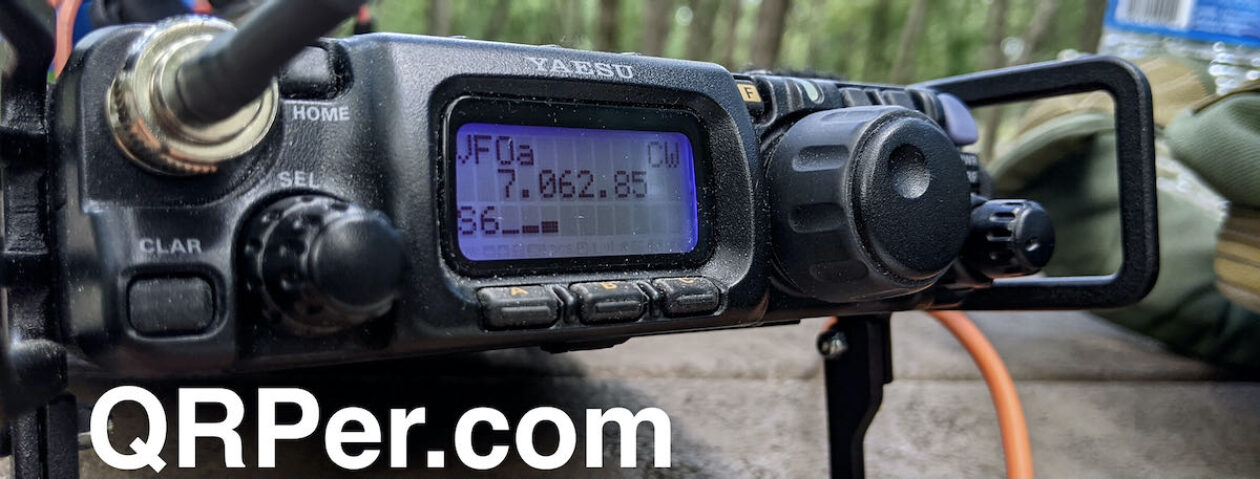On Friday, April 26, 2024, I dropped in on a POTA site I hadn’t visited in months: South Mountains State Park (US-2753).
The Clear Creek Access area–on the north west side of the park–is the quickest POTA detour for me as I travel from Asheville to Hickory along the I-40 corridor.
In my previous field report, I mentioned that my trips to Hickory have become less frequent compared to before, when I would go at least once a week. Now, when I do go, it’s typically not an overnight stay, which limits my opportunities for activations.
That Friday, the weather was predominantly wet. As I drove up to the Clear Creek parking area, clouds had rolled in and it was lightly raining. It was one of those days I wish I had packed my TX-500.
Fortunately, I typically set up under a large oak tree at this site and I knew it would offer pretty good protection from the rain.
 Upon arriving at the site, I was surprised by the number of parked vehicles. Ordinarily, I would expect to see only one or two other vehicles besides my own, but on this rainy day, there were about a dozen. This is the largest number of vehicles I’ve ever observed at the Clear Creek access.
Upon arriving at the site, I was surprised by the number of parked vehicles. Ordinarily, I would expect to see only one or two other vehicles besides my own, but on this rainy day, there were about a dozen. This is the largest number of vehicles I’ve ever observed at the Clear Creek access.
 I was a little worried that the one lonely picnic table at this site would be occupied, but fortunately, it was not.
I was a little worried that the one lonely picnic table at this site would be occupied, but fortunately, it was not.
I later learned that the bulk of the cars were there because a homeschool group was visiting. In fact, at one point, you’ll hear me speaking to one of the homeschool moms about amateur radio in the activation video below. That’s what I love about homeschoolers: they’re always ready to approach and ask questions!
 I reached the picnic table and started setting up my field kit.
I reached the picnic table and started setting up my field kit.
 I had a simple, but effective pairing in mind for this activation: my Elecraft KX2 and Packtenna 9:1 random wire. In the past, I’ve used this combo numerous times with great success.
I had a simple, but effective pairing in mind for this activation: my Elecraft KX2 and Packtenna 9:1 random wire. In the past, I’ve used this combo numerous times with great success.
 What I love about a good random wire is just how easily I can hop from one band to another.
What I love about a good random wire is just how easily I can hop from one band to another.
Setup was simple and pretty speedy. Also, the tree did keep me pretty dry while it rained lightly.
Gear:
 Note: All Amazon, CW Morse, ABR, Chelegance, eBay, and Radioddity links are affiliate links that support QRPer.com at no cost to you.
Note: All Amazon, CW Morse, ABR, Chelegance, eBay, and Radioddity links are affiliate links that support QRPer.com at no cost to you.
- Elecraft KX2 with Windcamp X2 Side Rails and Cover
- Tufteln KX2 Protective Cover
- KXPD2 Paddles
- Elecraft KXBT2 Li-Ion Battery Pack
- LowePro CS60 Hard Side Case
- Packtenna 9:1 UNUN Random Wire Antenna
- ABR Industries 25’ RG-316 cable assembly with three in-line ferrites (Use Coupon Code ABR10QRPER for 10% Discount!)
- GoRuck GR1 USA
- Weaver arborist throw line/weight and storage bag
- GraphGear 0.9mm 1000 Automatic Drafting Pencil
- Rite In The Rain Top Spiral Notebook
- Camera: DJI OSMO 4 action camera with Sensyne Phone Tripod
- DJI Wireless Microphones
On The Air
 Propagation has been very flaky as of late, so I really wasn’t sure what to expect when I hopped on the air. Continue reading POTA at South Mountains: Wet Weather, Flaky Bands, but Brilliant Field Radio Fun!
Propagation has been very flaky as of late, so I really wasn’t sure what to expect when I hopped on the air. Continue reading POTA at South Mountains: Wet Weather, Flaky Bands, but Brilliant Field Radio Fun!












































